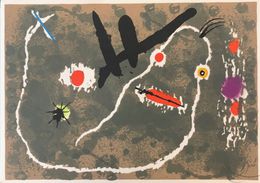


Non title
Joan Miró
Fine Art Drawings - 31 x 44 x 0.5 cm Fine Art Drawings - 12.2 x 17.3 x 0.2 inch
$62,628









Constellation III (Por Alberti, por l'Espana)
Joan Miró
Print - 90 x 66 x 0.2 cm Print - 35.4 x 26 x 0.1 inch
$22,036





























Galeria Maeght Barcelona ( Ref M 932 )
Joan Miró
Print - 69.5 x 52.5 cm Print - 27.4 x 20.7 inch
$12,816




Exposition à la Galerie Matarasso, Nice
Joan Miró
Print - 62 x 48 cm Print - 24.4 x 18.9 inch
$5,219


Affiche pour l'inauguration de la Fondació Joan Miró Barcelone
Joan Miró
Print - 70 x 50 cm Print - 27.6 x 19.7 inch
$6,379














A painting must be fertile. It must give birth to a world.
Biography
A Catalan painter by excellence, Joan Miró was born in Barcelona in 1893 and died on the 25th of December, 90 years later in Palma de Majorque in 1983. His homeland gave meaningful influence to his art, whether it was through painting, sculpture, engraving, or ceramics.
Alongside his parents, Miró became immersed in the creative world. His father was a jeweler and his mother was a cabinet maker. Miró initially enrolled into commerce school, with his father's encouragement, before giving up this career to take evening lessons at the Fine arts school of Llotja, in Barcelona. By 1912, he was adamant to become a painter. He joined the Galli Academy in Barcelona, directed by Francisco Galli, a trained architect, and discovered the great artistic trends in Europe.
Initially, Joan Miró displayed a style of painting that was related to fauvism, then cubism, and finally, expressionism. It was only when he arrived in Paris in 1919, that he felt fulfilled, artistically speaking. Miró turned towards fantasy for good. He became friends with artists like Max Jacob, Antonin Artaud, Tristan Tzara and André Masson: a group of emerging artists who yielded to aesthetic conventions and were open towards a new language. Once he freed himself from requirements and conventional methods, Miró flourished through simplicity.
Fascinated by the subconscious, he naturally rubbed shoulders with a group of surrealists in 1924. His several gouache partners were called André Breton, Paul Eluard, and Philippe Soupault. He enjoyed their off-the-wall humor, playful, and provocative minds. This led Miró to becoming more spontaneous and frequently thinking outside the box.
His participation reached its peak in 1925 during the "Surrealist painting" exhibition. A collective exhibition with Marx Ernst, Paul Klee, and Man Ray at the Galerie Pierre in Paris, where he presented his highly impactful "Carnaval d'Arlequin" painting. His painting "Birth of the World" in 1925 was also a big hit and materialized the bridge between Miró's original Catalan land and his Parisian blossoming.
It was in 1928 that Miró's relationship with the surrealist movement became complicated. Gradually, there were political tensions between the acolytes until 1930. Some of the members were open about supporting the Communist Party and the others preferred to depict their struggle through painting. Slowly, Miró withdrew and devoted himself to collages, giant sculptures and ceramics.
Nationality
Categories
Artistic movements
Themes








